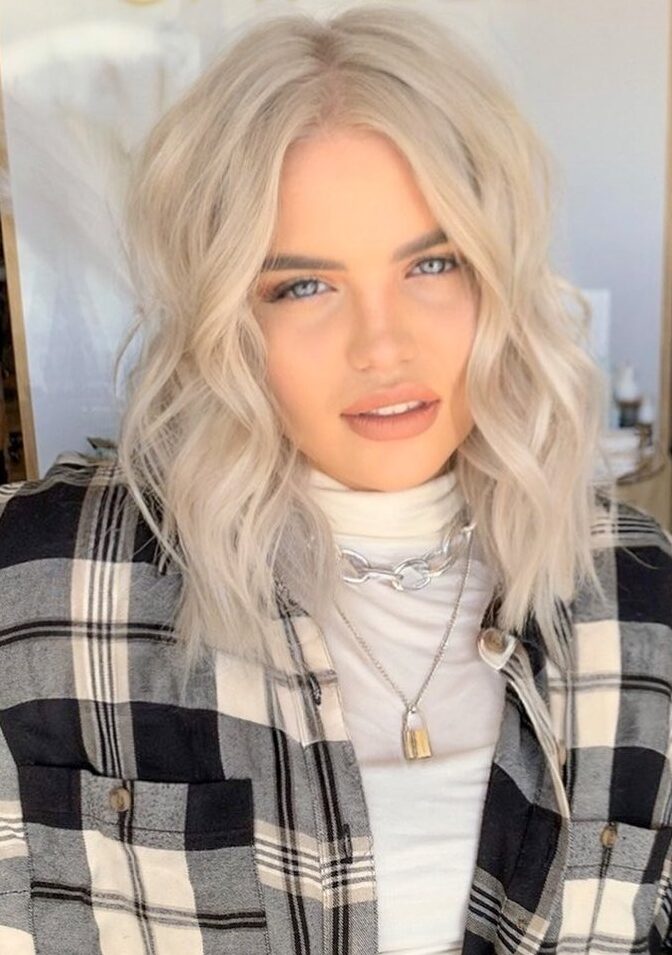
It is important for all hairdressers to perform a hair consultation prior to each appointment, especially for clients who are new to the salon. This consultation is recommended to provide hairdressers with the chance to learn crucial information about the hair of the client’s current history, hair type, and hair goals. With this information, you can make a plan for helping the clients to achieve from point A to B.
One aspect that could be crucial to the final result is the clients’ skin tone. Simply stated, certain colours of hair are more attractive or less on a person based on the distinct undertones present within their skin. The role of the hairdresser is to inform the clients about this connection.
Below we will explore the science of the relationship between hair colour and skin tone. We also look at some of the most popular skin undertones you’re likely to see and offer some examples to help you understand.
Though matching the hair colour of the client with the natural skin undertones of their skin can result in amazing results, it does not mean that the colour is unsuitable for someone due to the undertones. If the client shows up looking for a colour and the hairdressers don’t believe it is the right choice they’re looking for, they could and should explain to the client as to why they believe such a way and provide alternatives that are within the same colour family as the one they’re requesting. If, after this recommendation, the client still remains adamant about their initial choice it’s fine! The hairdresser will not be in charge to convince people to abandon their goals! If the client is making an educated choice, hairdressers will be all for it.
THEORY OF COLOUR: HAIR COLOUR AND SKIN UNDERTONES
Most often, people come with a desire for a hair colour that is not the right one to their skin tone. It all comes down to the concept of hair colour theory.
Conceptually, it is also known that a lot of times, hair is not able to lift to or retain the colour due to the quantity of eumelanin as well as pheomelanin that are present in the hair. The hair naturally desires to get back to the colour of melanin, its natural pigment. This is why removing the pigment is crucial. The more eumelanin is present in the hair the darker it normally is. The higher the amount of pheomelanin present in the hair, the more warm or more bright it appears.
Another reason this is more significant is because a specific skin tone can carry specific hair colour more effectively. The cooler shade of hair typically doesn’t complement the olive tone of skin. It is important to highlight the natural colour of your hair. This is essentially picking out the colour of the skin tone . This will draw out and complement the hair colour.
The most flattering colour for someone will change with the seasons. In summer, typically people’s features are warmer because of the sun’s rays and are able to wear shades that wouldn’t flatter them in other seasons. It is therefore important to take a look at your skin tone whenever you schedule appointments with your hairdressers at different seasons.
Another way to help in this regard is looking at the eye’s colour. It is possible that a client has cool skin tones with eyes that are warm, or vice versa a warm skin tone and an eye that is cooler. Hair colour is a great way to enhance and complement the eyes, too. It is possible to break the rules in these situations since either is complimented in a variety of ways.
SOME COMMON SKIN UNDERTONES
There are various warmer skin tones that need to be separately considered. Certain tones require calming down, while others need to be boosted.
For instance, skin that has pink undertones typically require to be calmed down by a cooler finish; however, there are those who can wear red and strawberry tones successfully. Yellow or golden tones will not go well with this skin tone because it’s two warm tones conflicting with each other.
The yellow tones of skin must be complemented by hair colour that can help to warm the skin, and not remove them. This usually means cooler, darker warmth like chestnut, as lighter hair shades usually contain too much yellow in the hair colour. It is important to bear in mind that a perfect match between the skin tone and hair is a NO-NO.
If there is more brownish in the skin tone, the more golden or amber is suggested is the hair’s shade. The ability to detect warmth in the eyes is essential since this is often the underneath pigments within the hair. When these tones are brought together, they create a gorgeous, well-balanced, finishing appearance. Consider the hues of autumn when you explore these skin undertones. Reflective and warm is always the aim.
If you have WARM undertones in your SKIN, what hair colours suit you best?
As mentioned, being able to identify the warmth is what determines the undertones that are present.
Warm can refer to yellow, golden or pink, caramel, or perhaps some neutral hues. Skin tones with pink tend to be soothed by a cooler hue and whenever we consider natural redheads, it is usually their skin’s undertone. The thing that is not mentioned is that there is a violet hue in pink, making pink sometimes a cooler shade and the reason why it can carry red well.
It’s not difficult to wash out a yellowish undertone in a client. Hence, picking a shade to enhance their warm skin tone and have a soft finishing is the best.
Above: Keeping the depth in this tone of skin helps bring everything in balance. Here is a stunning honey chestnut that adds such a bright completeness.
Above: Golden pink skin tones are perfectly complemented by warmer colours for hair. This illustrates how to use hair colour to bring out both the eyes and the colour of the skin by using warm copper and gold accents.
Above: More lustrous skin tones look stunning when paired by a shade that accentuates the warmth of the eyes. They are typically mahogany, gold and honey tones. The warmer and darker the eye colour is, the more warm the hair could be!
What hair COLOURS complements someone with COOL skin undertones?
Cooler pink undertones can be carried by the platinum, strawberry and pearl finishing. It is evident below showing how the eye colour could play a very significant role.
It is also crucial to be aware of the way makeup can completely alter the look and glow of a person. When during the hair consultation, hairdressers will normally also inquire about the usual makeup of the client as well.

Above: No doubt, green eyes are stunningly brightened by copper tones. This is a gorgeous strawberry blonde that enhances the eyes and skin tone.

Above: This light blonde looks also blend well with this beautiful client who has cool blue eyes with bright pink undertones too.
Which hair colour is the best if the clients have NEUTRAL UNDERTONES in the skin?
For neutral skin tones, it is best to take a look at the colour of the client’s eyes. Technically, the client can actually go for any hair colour, however, to really improve the look and make the eyes pop is the ultimate goal.

Above: The icy appearance of her eyes blends beautifully with the cool tones of her hair. Also, the mild warmth in the hair helps to complement the warmer areas of the face and not completely wash her out.
Above the sandy beige family can also blend well on those with neutral skin tone. It’s got a little warmth but it’s not shockingly clashing. It’s a perfectly well-balanced shade.
Tips for stylists working with undertones of the skin
Always refer to the colour wheel! This is among the many reasons that fundamental understanding on how to use the colour wheel is vital. The keynote is that every colour itself has a complementary tone which can help greatly when formulating eye colour and skin tone for every client.
Keep in mind that skin tone is seriously more than the skin colour itself. Lips, eyes, makeup, the colour of your eyebrows, makeup and even summer tans have a significant impact on the way that a person’s appearance is in balance. It’s possible to wear any hair colour, however, there are certain hues and tones that need to be balanced and blended together.
It is important to know that your hairdresser should know how to formulate actual tones, not just glosses that limit the raw lift tones which are the most beneficial actions for hairdressers. Every hairdresser can apply a gloss but do they formulate according to the tone the client needs?
Moreover, the hairdresser should know and understand how the colour line works and what the letters and numbers actually refer to. Swatches are helpful, but they are applicable on clear hair and may not be very accurate.
The theory of colour will be the most reliable guide to hairdressers in any of these scenarios. Colour theory is and will remain a science and an art form. It is important for hairdressers to understand the fundamentals and how various colours and undertones interact and they will then discover the rules that are required to offer to the clients to deliver the beautiful hair goals they’re seeking. Additionally, hairdressers must be aware of when it is possible to overstep the boundaries that can result in truly remarkable and amazing looks.


Leave A Comment